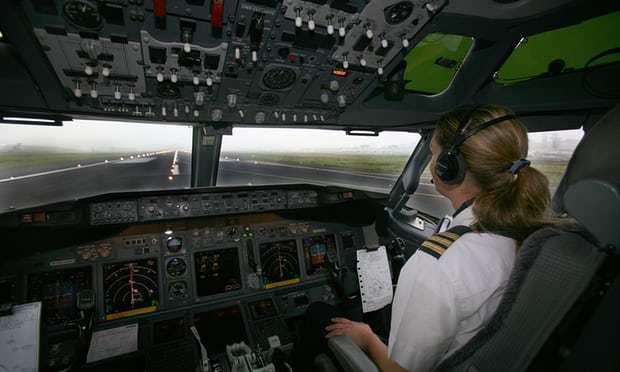
Some airlines want Boeing’s new ’797′ to fly with just one pilot on board. Boeing’s next commercial jet design could come with a cockpit built for just one pilot, according to industry analysts. Rumors have swirled for months that the U.S. plane manufacturer will announce a New Midsize Airplane (NMA), dubbed by industry insiders as the 797, at the Paris Air Show in 2019.
Decades ago, there was a flight engineer present in the cockpit of commercial airplanes whose job was to monitor aircraft systems and diagnose problems. With the advent of integrated circuits and advances in computing power during the early 1980s, this job was eventually eliminated. Today, we almost universally see two pilots in the cockpit. However, there is serious talk of reducing that number to one. Airbus and Thales have stated that this could become a reality as soon as 2023.
A heated debate is underway over the issue. Airlines would like to balance safety with profits. The FAA is tasked with keeping the flying public safe through regulation, oversight, and inspection. Pilots want to ensure safety and reasonable working conditions. And of course, the public ultimately drives this discussion with our pocketbooks. There are many different points of view, but for the sake of brevity, here are the three most common arguments that I keep hearing.
Three Arguments in Favor
It will ease the pilot shortage
It is no secret that the aviation industry faces a worldwide shortage of qualified pilots. The number of licensed pilots has decreased by about 30% over the past three decades. Numerous estimates cite the need to hire thousands of new pilots. Some air carriers reduce or cancel, flight schedules as a result of these pilot shortages. In an effort to pilot their fleets, airlines have increased wages and signing bonuses, among other things. In their eyes, one of the easiest ways to address this problem of supply is to reduce demand. By eliminating the co-pilot from the cockpit, they can remove much of the problem.
It would save the airlines lots of money
One obvious benefit of reducing the pilot pool is that you now also reduce the recurring salaries by the same amount. Airlines argue that they would save a lot of money by removing half of the pilots, as these are usually among their highest-paid employees. It will also help the airlines cut costs because they will no longer have to increase wages and signing bonuses since there will no longer be a pilot shortage. They say this will help to reduce ticket prices and that consumers will also benefit.
It gives aircraft manufacturers more options
If an aircraft manufacturer only has to accommodate one pilot in the cockpit, then they can start being more creative with their designs. Furthermore, they can start allowing the automation to do more, as they did when the flight engineer was removed many decades ago. Programmers generally argue that automation is superior to human pilots. Flights are smoother and more fuel-efficient, as the automation is able to make a million decisions per second, while a human is simply human. In fact, some airlines will not allow their pilots to fly manually during certain periods of flight. A survey of Airbus and Boeing pilots found that they manually fly about 3-6 minutes per flight; the rest of the time is in autopilot mode. Presumably, the amount of autopiloted flight would increase with the elimination of the co-pilot.
Three Arguments Against
Automation is not perfect
As we have seen from the Boeing 737 Max crashes in Indonesia and Ethiopia, disasters can occur from human-automation interaction in the cockpit. There is a laundry list of accidents at least partially caused by breakdowns in the human-automation team. Some, like Air France flight 447 from Brazil to Paris, resulted in total loss of life on board. Even highly reliable automation can create problems by eroding pilots’ manual flying skills and breeding complacency and lack of situational awareness. When automation fails, the pilot is often left struggling to figure out what went wrong.
There will be a loss of human redundancy
From the time they enter the cockpit, the captain and first officer work as a team. They coordinate the prepping of the aircraft, go through the checklists together, and decide as a team when they are ready for flight. This procedure has huge benefits. First, it encourages accountability. Having someone present to verify that you have done your job increases compliance. Second, having a second pair of eyes helps to detect problems or issues as they arise. One pilot alone cannot see two things at once; they cannot both scan the outside while monitoring displays. Third, it offers huge benefits during emergencies and decision-making processes. A co-pilot is good for helping to maintain calm and professionalism. A co-pilot helps by going through the emergency checklist while the captain aviates. A co-pilot is good for bouncing ideas off when things get messy. One must wonder how difficult it would have been for Captain Sullenberger to land that airplane in the Hudson River without Jeff Skiles.
The flight is more likely to wind up completely pilotless
Removing the co-pilot will mean that if the pilot becomes incapacitated, then you will be on an airplane with no one in control. Just like everyone else on board, pilots often fall asleep in airplanes, even when they are in the cockpit. A survey of pilots showed that more than half of them have slept while flying. The fatigue problem has gotten so bad that some airlines allow pilots to take naps in the cockpit. Second, if a pilot has a heart attack or other potentially fatal event, there will be no one there to notice, especially on a long-haul flight. Third, hypoxia (a loss of oxygen) affects people differently. One pilot might start experiencing symptoms before another one does, and the second pilot would notice this and remediate the situation. A pilot by herself could just pass out, leaving the aircraft pilotless. The rest of the flight crew and passengers would be completely clueless.
Conclusions
Clearly this is a hot button issue, and both sides take their arguments very seriously. A thorough discussion must occur before policies are made that could negatively affect aviation safety.
Boeing said the NMA was not a plane that would herald a technological revolution. “We remain focused on executing on our commitments, including evaluating the business case for the NMA. With that said, should we launch, the NMA flight deck is being designed for two pilots and we’ve been consistent that we don’t see NMA as a technology push airplane,” it read.

